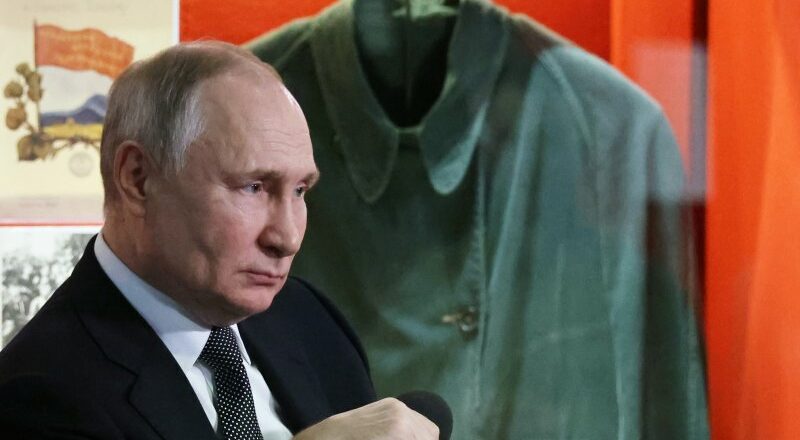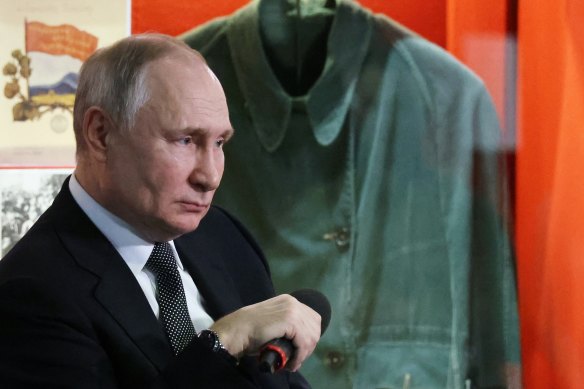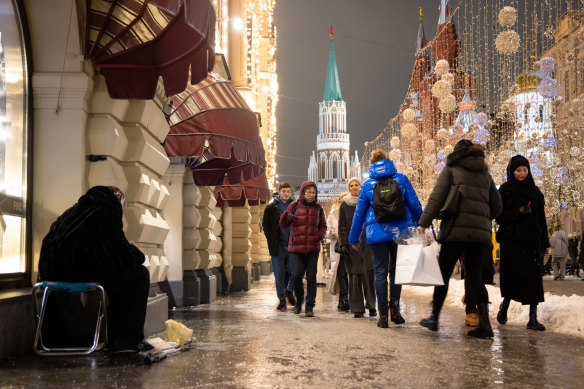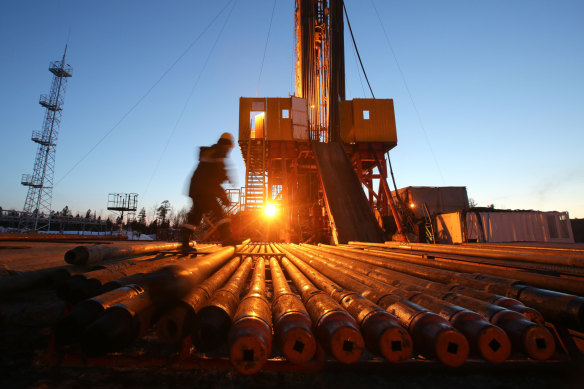Vladimir Putin no longer has the money or the kit to sustain a modern war
Save articles for later
Add articles to your saved list and come back to them any time.
Sanctions against Russia have been the unsung success story of the advanced democracies. Vladimir Putin’s ability to wage military war against Ukraine, and geo-ideological war against the liberal world, is being ground down systematically with each passing month.
Earnings from Russia’s oil and gas exports fell by 52 per cent over the first four months of this year, and hydrocarbon rent is what funds two-fifths of the Kremlin’s budget.
Putin faces a delicate balancing act as he continues to marshal resources for his war without antagonising a population that’s increasingly worried about its financial wellbeing.Credit: AP
Last year, Putin had no difficulty financing his invasion from the windfall gains of the energy price spike, caused in large part by his own actions. He could raise pensions by 10 per cent and scatter enough money to shield Russia’s people from the hardship of the war. This year he will have to choose between guns and butter.
It was never going to be easy to blockade the world’s largest country, central to the international supply of grains, fertilisers, energy, and the gamut of critical commodities. Nor was it ever going to be possible to corral the global South without provoking a backlash and splitting the world into two camps.
Yet so far, the democracies have navigated this war with skill. I hesitate to talk of the “West” in this context because that plays to Xi-Putin propaganda. The Eastern democracies of Japan, Korea, and Taiwan are also participating in the soft blockade.
Europe has survived the loss of Putin’s gas in a better shape than most could have imagined a year ago, least of all Putin. Prices have collapsed to €25 ($US41) MWh from a peak of €304 last August. They are not far above the median price of the last decade. The January TTF contract is €43.
We no longer have to fear a second and even more painful energy shock this winter. Gas storage tanks are already 75 per cent full in Germany and 74 per cent in Italy, at least 20 points higher than the seasonal norm.
China’s stalled recovery has cratered Asian demand for liquefied natural gas (LNG). Tom Marzec-Manser from analysts ICIS said LNG cargoes are instead flooding into Europe at “record volume”
Russia has lost all but a sliver of its European gas market, and lacks the pipelines to switch its West Siberian wells to Asia. Europe’s gas demand is henceforth on a rapid downward slope.
JPMorgan says last year’s shock forced a permanent shift in behaviour that has already cut gas needs by 5 per cent. The breakneck roll-out of wind and solar will mechanically slice it by another 20 per cent this decade.
The Russian economy is feeling the hardships of the war against Ukraine.Credit: Bloomberg
Yes, Russia is still selling near record amounts of oil. This is a feature, not a bug, of the G7’s $US60 price cap, introduced last December.
“The mechanism was designed to reduce export prices for Russian crude oil and petroleum products, not to reduce export volumes,” said the Finnish central bank.
The purpose of the cap is to dry up Putin’s revenue stream without causing a global oil shock and a political uprising in Europe. It is working like a charm.
The International Energy Agency says Russian Urals crude traded at average of $US52 over the first quarter, half the level of a year ago and a $US25-30 discount against Brent.
The democracies control 90 per cent of the world’s tanker fleet through direct ownership or through financing and the P&I club that covers complex spill liability for shipowners, at $US1 billion a shot. Without insurance you cannot take these floating firebombs through the Oresund or the Bosphorus, or enter most of the world’s ports.
Putin can export as much oil as he wants in G7-controlled ships so long as he complies. He vowed defiance, issuing a decree prohibiting the sale of Russian crude to any entity abiding by the G7 cap.
It was an implicit threat to withhold 4 per cent of the world’s supply of crude. In the end, Putin meekly complied. He does not have the money to sustain a long oil war, and he cannot risk permanent damage to his oil fields (already in trouble).
The oil cap has worked like a charm, drying up Putin’s revenue stream without causing a global oil shock.Credit: Bloomberg
Putin is of course free to sell seaborne oil at any price to China, India, or any country using ships outside the G7 nexus. Trafigura says he has collected a “shadow fleet” of some 500 ships, drawing on a network of global shell companies using old tankers that operate with their transponders switched off.
Using this dark fleet comes at a stiff cost. Some 80 per cent of Russia’s tanker exports of crude and its products leave western ports in the Baltic and the Black Sea. The system was designed to supply Europe.
The round-trip from St Petersburg to Hamburg takes six days. The round-trip to Shanghai takes 90 days, with freight rates, crew fees, and bunker fuel costs to match. There is a further snag: Russian ports cannot handle Suezmax supertankers. The oil has to be shipped in smaller Aframax tankers, and is then transferred to the big beasts at semi-clandestine spots, off Ceuta and off the Greek Peloponnese.
This may be an ecological nightmare but it is not a breach of sanctions – unless operations are a front for Greeks shipowners, as Ukraine alleges – but it is not a failure of G7 policy. It costs Putin an extra $US12 a barrel to reach markets in Asia.
Indian and Chinese traders then beat down the price, knowing that he is a distressed seller. “I doubt that Russia is netting more than $US20 a barrel given their own cost of production,” said Prof Alan Riley from the Atlantic Council.
Putin cannot fund a war machine on this. Russia’s budget deficit for the first four months of this year ballooned to $US40bn, blowing through the target for the whole of 2023.
The country can no longer borrow abroad – not even China is stepping in with real money – and lacks a deep bond market at home. The Atlantic Council says the Russian treasury has managed to raise $US12.5bn in OFZ bonds this year but at a punitive rate above 10 per cent.
The Kremlin is now shaking down its own oligarch base, forcing “voluntary” contributions. “Large firms are increasingly subject to the whims of those in power,” says the Finnish central bank.
The treasury has so far covered much of the deficit by running down its current account. This is unsustainable. Putin can raid the rainy-day welfare fund for a while, $US155 billion if you believe Russian data at this juncture, but much of it is in illiquid holdings, such as a stake of Sberbank. A crunch is coming.
Economic blockades can never win a quick war. But the G7 squeeze is degrading Putin’s war machine sufficiently to give Ukraine a fighting chance.
The US Centre for Strategic & International Studies (CSIS) estimates that Russia has lost up to 40 per cent of its pre-war tank fleet. It continues to lose 150 tanks a month but can produce only 20 a month at its UralVagonZavod plant.
Russia is drawing down on its Soviet reserve, with T64 and even T55 tanks appearing on the battlefield. It lacks the hi-tech components to upgrade these dinosaurs with accurate sights, causing a two kilometre loss of range.
It is the same story to varying degrees with artillery, rocket systems, helicopters, and electronic warfare. The shortage of high-quality bearings and microchips is holding back war repair and production.
Russia needs 30,000 basic chips a month to keep the show on the road: it makes only 8,000. It can buy chips from China but these have to be redesigned fundamentally to fit a technology system that evolved using chips from Intel or Advanced Micro Devices.
The CSIS says Sukhoi Superjet 100 aircraft are being held together with 17 components from old engines. KamAZ is again building antique 820 (V8) tractor engines because China’s Weichai cut off the supply of advanced engines for fear of sanctions. Russia no longer has access to the precision machine tools needed to sustain a cutting-edge war machine.
The Kremlin can continue to rely on the global black market to smuggle in key components. But it all takes time and money. Russia has neither as Ukraine prepares its counter-offensive. Sanctions are most assuredly working. Besides, there is no other moral choice.
The Business Briefing newsletter delivers major stories, exclusive coverage and expert opinion. Sign up to get it every weekday morning.
Most Viewed in Business
From our partners
Source: Read Full Article




